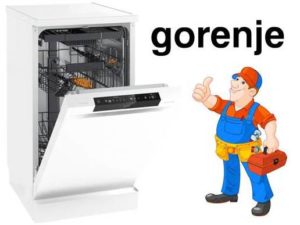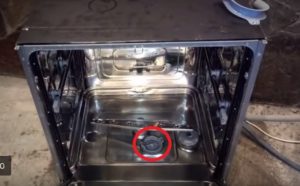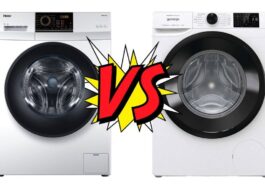Dishwasher repair Gorenje
 There are many fans of the Gorenje technique who claim that it is so reliable that it almost does not break. Our craftsmen do not share their optimism, so they helped prepare this publication, in which, in their words, we described in detail the repair of Gorenje dishwashers, based on the most typical malfunctions of these “home helpers.” We hope this information will be useful for active users and novice craftsmen.
There are many fans of the Gorenje technique who claim that it is so reliable that it almost does not break. Our craftsmen do not share their optimism, so they helped prepare this publication, in which, in their words, we described in detail the repair of Gorenje dishwashers, based on the most typical malfunctions of these “home helpers.” We hope this information will be useful for active users and novice craftsmen.
What breaks most often?
It is clear that anything can break in any dishwasher; absolutely reliable equipment does not exist. However, any brand of dishwashing equipment has its own weaknesses, which result in so-called typical problems, let's look at them.
- The “disease” of Gorenje dishwashers is clogs. It would be more correct to say that this is a “disease” not of dishwashers, but of their owners, who neglect the basic rules of caring for their “home help.”
It is recommended to clean the filters at least once every 3 months, preferably more often.
- Another weakness of Gorenje machines is the thermistor, which burns due to voltage surges and system failures. The heating element fails a little less often.
- Often a sensor is triggered, protecting the machine from leaks. This sensor is located in the pan and can work, so to speak, empty, in the absence of a leak.
- The pump on Gorenje machines also causes complaints from some craftsmen. 9% of all breakdowns are related to the drain pump, a fairly high percentage.
The latest models of Gorenje dishwashers have problems with the firmware of the control module. Most often, the problem is solved by resetting the firmware, but sometimes it requires a complete replacement. This kind of work is done exclusively by a good craftsman. If you get into the firmware without experience and relevant knowledge, you can seriously screw up and end up with expensive repairs.
Cleaning the machine
 Cleaning the machine from dirt is the responsibility of the user. If he neglects this, he will end up with a blockage that will stop the dishwasher from working. If the machine drains water slowly or does not drain it at all, then you need to urgently clean the garbage filter. This filter is located at the bottom of the washing chamber. It must be washed thoroughly but carefully using dishwashing gel.
Cleaning the machine from dirt is the responsibility of the user. If he neglects this, he will end up with a blockage that will stop the dishwasher from working. If the machine drains water slowly or does not drain it at all, then you need to urgently clean the garbage filter. This filter is located at the bottom of the washing chamber. It must be washed thoroughly but carefully using dishwashing gel.
You also need to check the drain hose; clogs often accumulate there too. You also need to inspect the siphon fitting. There, the dirt accumulates in a dense lump and over time, water stops passing through this lump. All this can be easily cleaned. It is enough to disconnect the drain hose from the fitting and pry through the inlet with a screwdriver, removing the dirt.
Another filter that should be checked regularly is the intake valve filter. You can get it out by unscrewing the inlet hose of the Gorenye dishwasher. The filter is a small plastic mesh that becomes clogged with lime deposits quite quickly. If your water supply has hard water, the mesh should be checked at least once every 3 months. After removing the mesh, clean it thoroughly and return it to its place.
Checking the temperature sensor and heating element
If you find that your Gorenje dishwasher refuses to heat the water, most likely its temperature sensor or heating element has failed. Heating elements fail less often, but sometimes they still have to be replaced.And to change the heating element in a Gorenye dishwasher, that’s a whole story. The fact is that the heater of the Gorenje dishwasher is located in the depths of the circulation block. To get to it, you need to completely remove the pan, disconnect the power supply from the heating element and pull the part out of the groove.
First you need to check the heating element with a multimeter for leakage, and then measure the resistance. The resistance of the working part is approximately 30 Ohms.
The heating element may turn out to be working, then you need to switch your attention to the temperature sensor. We measure its resistance, and if it turns out that the indicators tend to zero, the temperature sensor needs to be changed.
Leakage sensor triggered
The leak sensor works on a very simple principle. Inside the dishwasher body, in the tray, there is a sensor connected to a float. If water rushes into the pan, the float will instantly float up, carrying the bar with it, which will close the contact. This contact will instantly send a signal to the control module, which will immediately block the water supply and stop the operation of the dishwasher.
To check this sensor, remove one of the side walls of the Gorenje machine body. Stick your hand into the hole formed and feel if there is water in the pan. If there is a lot of water, you need to tilt the machine on its side and drain everything. Then look at where the water is dripping from and try to determine the location of the leak. After replacing the leaky pipe or gasket, you can start the machine again.
Let's assume there is no water in the pan. This means the sensor is simply stuck. You need to move the float by moving it down. Then the contacts will open and the machine will begin to function as usual.
The pump does not pump out water
When pumping waste water into the drain, the dishwasher pump makes a fairly loud noise.It’s impossible not to hear it, so if suddenly the hum disappears, and dishwasher does not drain water, which means you need to check the pump. To remove and check the pump, you do not need to disassemble the entire dishwasher.
- It is enough to remove the side wall of the Gorenje dishwasher.
- Disconnect the pump from the circulation unit.
- Remove the wires from it.
- Check the drain pump with a multimeter.
- Replace if it turns out to be faulty.
In conclusion, we note that fixing many problems with the Gorenye dishwasher with your own hands is not so difficult. You can get to the parts you are looking for almost right away, but there are defects that should only be trusted to professionals, otherwise you can only aggravate the problem and make repairs much more expensive. Good luck!
Interesting:
Reader comments
- Share your opinion - leave a comment
Categories
Washing machine repair


For buyers

For users

Dishwasher


















Add a comment